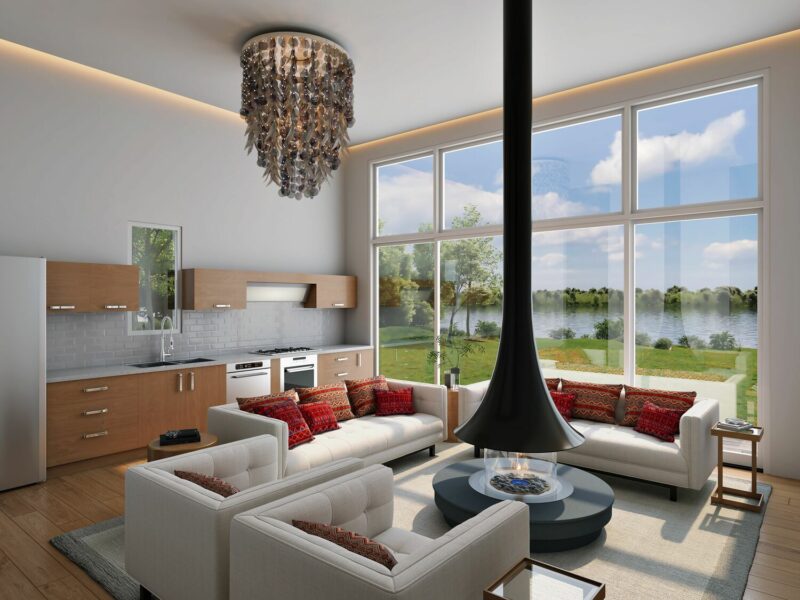

“What is the use of a house if you don’t have a decent planet to put it on?” — Henry David Thoreau
Throughout most of history, houses didn’t have to do much to be green. They were innately sustainable, using local materials, and in harmony with their climate and culture. Think of the Thai thatch hut, the Icelandic turf house, Inuit igloos or Pueblo cliff dwellings.
Then there’s the Hamptons.
In our corner of the world, mega mansions have their own guest mansions, and pool houses can be bigger than most human dwellings. Throw a Manolo Blahnik shoe in any direction and it has a good chance of landing on the overly landscaped lawn of an unused estate.
But all that’s starting to change. Bigger-is-better showmanship is finally going the way of the Hummer and fountains in swimming pools. Today, homes are more likely to be powered by solar, tightly insulated, heated with geothermal, smaller in scale, and getting closer to net zero carbon emissions (when a house doesn’t use more energy than it generates.)
All of this common sense design couldn’t have come at a better time. In 2019, residential energy use in the U.S. accounted for roughly 20 percent of our greenhouse gas emissions. This year, the building sector worldwide used 32 percent of all energy generated (more than one third of that for heating and cooling alone).
The first thing that surprised me when I visited a fully net zero house this January was how, well, normal it was. Normal in a fabulously elegant, modernist East Hampton kind of way, that is. As Marc Cléjan, founder of Modern Net Zero put it, “You don’t see the green.”
Cléjan, who uses “net zeroing” as a verb, and has been building beautiful, carbon neutral homes like this one since 2013, says that when it comes to beauty and sustainability, “Most people don’t know they can have their cake and eat it too.”
It also surprised me that the lights had been left on and the heat was set to 68 even though the owner hadn’t been there in weeks. After a lifetime of being scolded for leaving lights on, it was kind of astonishing that this house wasn’t wasting energy. “When a house is really efficient, you don’t need to worry so much about electricity. You can, ‘Set it and forget it,’” says Cléjan.
The first step to building to a net zero home is good orientation, siting a home on the property for windows to take advantage of the sun in order to create “passive” solar heating. In the summer, sun doesn’t come in at all, keeping the house pleasantly cool so that you don’t have to blast the AC. Then in the winter, sun should flood the house all the way through to the back wall for maximum heat and light.
Architect Nina Edwards Anker, whose home in Southampton uses passive solar heat, says, “One of my favorite times of year is a sunny winter day, sitting in a T-shirt in the living room with no heat on and it’s still so warm.”
The home’s “envelope” should also be tight and well insulated in order to retain heat in the winter and maintain coolness in the summer. Installing quality doors and triple glazed windows and sealing them properly is the key to maximizing energy efficiency.
Another important heating and cooling method is using geothermal energy. Rather than a furnace blasting hot air from vent at 130 degrees, geothermal gives the house a steady heat that doesn’t dry everything out (including your skin).
A house that’s as healthy to live in as it is for the environment should include an ERV (energy recovery ventilation) system. Considered “the lungs of the house,” ERVs take hot stale air out of the home and pump beautiful fresh air into it, helping to heat the home in the winter, and cool it in the summer, all while using very little energy.
Smaller houses, which use less CO2 in construction, and are easier to make net zero, are becoming much more popular, even on the East End.
“A lot of the people who have the means to build big houses are choosing to build small because they just don’t want to spend money on energy,’” says Sheri Koones, author of “Prefabulous Small Houses.” “They don’t want to be spending their weekends maintaining a big house.”
The most beautiful example I’ve seen yet of a sustainably built small home is a 500 square foot gem on Shinnecock Bay that cost $140,000 to build. (Happy face emoji!) Built with ecological timber from Home Depot, its efficient design uses thick northern walls to retain heat, while large, southern facing windows create passive solar heat. A tall ceiling and big windows looking out over the water make it feel bigger than it actually is. In the Shinnecock tradition, a central wigwam allows community to gather round the hearth and connect to the water.
“The most environmental way to build, is not to build,” says builder Peter Sabbeth. For those of us who have no plans to move, there are still plenty of ways to get our homes closer to net zero, or at least make them more energy efficient.
Little investments can make a big difference. Switch to smart thermostats that can be programmed to predict your routine. Check out low-E glass coating that helps improve insulation without blocking visible light. Since an LED bulb uses less 90 percent less energy than an incandescent bulb, update to energy-efficient LED light fixtures. Even something as simple as good quality window shades help to keep temperatures cooler in the summer.
There’s a world of crazy new innovations on the horizon that are being explored and tested every day. Sustainably made cement can include left over charcoal waste, disposed of glass, or even “hempcrete.” While not Bob Marley smokable, it’s much more sustainably made than traditional cement.
Roofs can be made of recycled rubber and beverage cans. Countertops are being made with biodegradable cork. Insulation is being made from straw bales and sheep’s wool. Since sheep naturally reproduce their coat throughout the year, they’re the insulation that keeps on giving.
There’s even an environmental plywood called CLT that, according to Sabbeth, “Is crazy strong. They can make skyscrapers out of it without using steel.”
The Cha-Ching Factor:
Net zero houses are not only carbon free. They’re bill free. More often than not, you end up creating excess energy to either sell back to the grid, or used as credit to pay the winter energy bill (assuming there is one). Modern Net Zero homes are designed to save an average of $15,000 to $30,000 per year on energy bills and maintenance.
Note: If you’re the sort of person who likes long conversations debating faucet handles and changing the style of a bathroom vanity on a whim, Modern Net Zero homes aren’t for you. One reason these houses save money is because everything is completely streamlined and predetermined, thereby shrinking the projects’ construction time and cost.
While Cléjan builds homes to reduce energy consumption, his wife, Anna, focuses on energy of a more spiritual nature. As a professional healer, she blesses the house and land it’s being built on with good energy. She conducts a ceremony using crystals to ask permission from the land to build, and then invites the animals back after construction.
One celebrity client who recently bought a Sagaponack home noted that she couldn’t put her finger on it, but said, “The house just has good juju.” Personally, I’d like to think that living in a home that uses less fossil fuels is what brings on the good juju.
 More Posts from Jenny Noble
More Posts from Jenny Noble